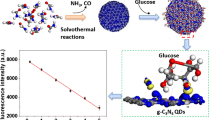Abstract
This work presents a simple, economic and green technique for functionalizing fluorescent silicon quantum dots (Si QDs) as a bioprobe to measure blood glucose levels. The functionalized Si QDs are synthesized by adding 3-aminopropyltriethoxysilane to a colloidal solution of Si QDs, freshly prepared by laser ablation of a silicon target in distilled water. The amine-terminated surface of Si QDs is confirmed using Fourier transform infrared spectroscopy, energy dispersive x-ray spectroscopy and UV–visible absorption spectroscopy. The photoluminescence of the colloid exhibits high photo-stability and good reproducibility making it a good candidate for fluorescent probes in biosensor studies. We have investigated the use of such functionalized Si QDs as a probe for fluorescent glucose detection application based on its effective fluorescence quenching by hydrogen peroxide, which is produced from glucose. The room temperature fluorescent glucose sensor, based on amine-functionalized Si QDs, gave a detection limit of 0.97 μM and a linear range from 20 to 700 μM. This non-enzymatic fluorescent biosensor system shows high sensitivity, excellent selectivity and extreme stability toward glucose.
Similar content being viewed by others
References
J. Kim, A.S. Campbell, and J. Wang, Talanta 177, 163 (2018).
Y. Yi, J. Deng, Y. Zhang, H. Li, and S. Yao, Chem. Commun. 49, 612 (2013).
M. Amatatongchai, W. Sroysee, S. Chairam, and D. Nacapricha, Talanta 166, 420 (2017).
X. Cheng, L. Huang, X. Yang, A.A. Elzatahry, A. Alghamdi, and Y. Deng, J. Colloid Interface Sci. 535, 425 (2019).
H.Y. Lee, J.J. Lee, J. Park, and S.B. Park, Chem. Eur. J. 17, 143 (2011).
L. Cao, J. Ye, L. Tong, and B. Tang, Chem. Eur. J. 14, 9633 (2008).
M. Shehab, S. Ebrahim, and M. Soliman, J. Lumin. 184, 110 (2017).
M. Rodio, R. Brescia, A. Diaspro, and R. Intartaglia, J. Colloid Interface Sci. 465, 242 (2016).
M. Taheri, F. Hajiesmaeilbaigi, and A. Motamedi, Thin Solid Films 519, 7785 (2011).
M. Taheri, F. Hajiesmaeilbaigi, A. Motamedi, and Y. Golian, Laser Phys. 25, 065901 (2015).
M. Taheri, Laser Phys. 28, 125401 (2018).
X. Li, Y. He, and M.T. Swihart, Langmuir 20, 4720 (2004).
D. Tan, Z. Ma, B. Xu, Y. Dai, G. Ma, M. He, Z. Jin, and J. Qiu, Phys. Chem. Chem. Phys. 13, 20255 (2011).
S. Chandra, G. Beaune, N. Shirahata, and F.M. Winnik, J. Mater. Chem. B 5, 1363 (2017).
W. Wu, H. Hao, Y. Zhang, J. Li, J. Wang, and W. Shen, Nanotechnology 29, 025709 (2018).
S. Godefroo, M. Hayne, M. Jivanescu, A. Stesmans, M. Zacharias, O. Lebedev, G. Van Tendeloo, and V.V. Moshchalkov, Nat. Nanotechnol. 3, 174 (2008).
Y. Xu and Y. Han, Appl. Phys. A 117, 1557 (2014).
J. Wang, J. Guo, and J. Chen, Sensors 17, 2396 (2017).
J. Zou, R.K. Baldwin, K.A. Pettigrew, and S.M. Kauzlarich, Nano Lett. 4, 1181 (2004).
M. Taheri, Z. Feizabadi, S. Jafari, and N. Mansour, J. Electron. Mater. 47, 7232 (2018).
H.H. Mai, V.T. Pham, V.T. Nguyen, C.D. Sai, and C.H. Hoang, J. Electron. Mater. 46, 3714 (2017).
C. Wang, S. Shu, Y. Yao, and Q. Song, RSC Adv. 5, 101599 (2015).
Z.F. Gao, A.Y. Ogbe, E.E. Sann, X. Wang, and F. Xia, Talanta 180, 12 (2018).
M. Hu, J. Tian, H.-T. Lu, L.-X. Weng, and L.-H. Wang, Talanta 82, 997 (2010).
C. Chen, Y. Zhang, Z. Zhang, R. He, and Y. Chen, Anal. Lett. 51, 2895 (2018).
Acknowledgments
The authors would like to thank Saeed Javadi Anaghizi in Center Laboratory of the Shahid Beheshti University for providing EDX analyses.
Author information
Authors and Affiliations
Corresponding author
Additional information
Publisher's Note
Springer Nature remains neutral with regard to jurisdictional claims in published maps and institutional affiliations.
Rights and permissions
About this article
Cite this article
Taheri, M., Mansour, N. Highly Sensitive Fluorescence Assay for Glucose Using Amine-Terminated Silicon Quantum Dots As a Non-enzymatic Bioprobe. J. Electron. Mater. 48, 5875–5882 (2019). https://doi.org/10.1007/s11664-019-07368-3
Received:
Accepted:
Published:
Issue Date:
DOI: https://doi.org/10.1007/s11664-019-07368-3




